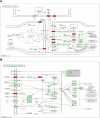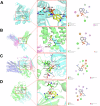The molecular mechanisms through which psilocybin prevents suicide: evidence from network pharmacology and molecular docking analyses
- PMID: 40523911
- PMCID: PMC12170861
- DOI: 10.1038/s41398-025-03410-7
The molecular mechanisms through which psilocybin prevents suicide: evidence from network pharmacology and molecular docking analyses
Abstract
Psilocybin is among the most extensively studied psychedelics, with previous research suggesting its potential therapeutic role in suicide prevention. However, the precise mechanisms through which psilocybin may aid in suicide prevention remain unclear. This study thus employed network pharmacology and molecular docking tools to explore the mechanisms by which psilocybin may contribute to suicide prevention. Relevant drug- and disease-related targets were identified. Overlapping drug- and disease-related targets were extracted from the bioinformatics platform and imported into the STRING database to construct a protein-protein interaction (PPI) network. Key targets were selected based on topological parameters derived from network analyses conducted using Cytoscape 3.10.1. These key targets were further analyzed using GO and KEGG enrichment approaches conducted with the DAVID tool. A drug-disease-target-pathway network was subsequently constructed in Cytoscape 3.10.1. Finally, molecular docking analyses were performed to assess psilocybin's potential to interact with key targets using AutoDock Vina and the PyMOL software. A total of 46 potential targets associated with psilocybin and relevant to suicide treatment were identified, of which 13 were imported into the DAVID tool for enrichment analyses. Network analyses identified four targets-HTR2A, HTR2C, HTR7, and PRKACA-that may serve as therapeutic targets for psilocybin in suicide prevention. Enrichment analysis outcomes suggested that psilocybin may prevent suicide by modulating the serotonergic synapse and calcium signaling pathways. Molecular docking analyses revealed that HTR2A, HTR2C, HTR7, and PRKACA strongly bind to psilocybin. This study provides insights into the molecular mechanisms underlying the potential role of psilocybin in suicide prevention, offering a novel basis for further research.
© 2025. The Author(s).
Conflict of interest statement
Competing interests: The authors declare no competing interests.
Figures





Similar articles
-
Multi-target Mechanisms of Si-Ni-San on Anxious Insomnia: An Example of Network-pharmacology and Molecular Docking Analysis.Curr Med Chem. 2025;32(13):2640-2663. doi: 10.2174/0109298673299665240924090617. Curr Med Chem. 2025. PMID: 39410900 Free PMC article.
-
Mechanisms of Actinidia chinensis Planch roots in the treatment of breast cancer based on network pharmacology and molecular docking.Medicine (Baltimore). 2025 Aug 1;104(31):e43560. doi: 10.1097/MD.0000000000043560. Medicine (Baltimore). 2025. PMID: 40760645 Free PMC article.
-
Elucidating the Mechanism of Xiaoqinglong Decoction in Chronic Urticaria Treatment: An Integrated Approach of Network Pharmacology, Bioinformatics Analysis, Molecular Docking, and Molecular Dynamics Simulations.Curr Comput Aided Drug Des. 2025 Jul 16. doi: 10.2174/0115734099391401250701045509. Online ahead of print. Curr Comput Aided Drug Des. 2025. PMID: 40676786
-
Study on the mechanism of Shujin Tongluo granules in treating cervical spondylosis based on network pharmacology and molecular docking.Medicine (Baltimore). 2023 Jul 21;102(29):e34030. doi: 10.1097/MD.0000000000034030. Medicine (Baltimore). 2023. PMID: 37478234 Free PMC article.
-
Exploring the mechanism of ShenGui capsule in treating heart failure based on network pharmacology and molecular docking: A review.Medicine (Baltimore). 2024 Apr 5;103(14):e37512. doi: 10.1097/MD.0000000000037512. Medicine (Baltimore). 2024. PMID: 38579077 Free PMC article. Review.
References
MeSH terms
Substances
LinkOut - more resources
Full Text Sources
Miscellaneous

